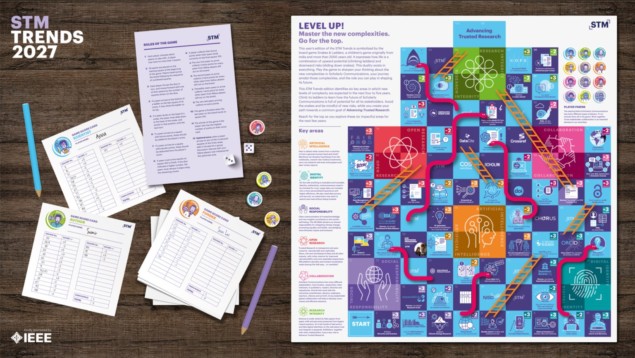
One of the great things about working on Physics World is that I learn something new just about every day. And this Wednesday was no exception, when I learned about the origins of Snakes and Ladders.
The popular board game came up at internal conference at IOP Publishing, where one of the guest speakers was from STM — an industry association that represents the interests of academic publishers around the world. Towards the end of last year, STM held a meeting in London that brainstormed scenarios for how scholarly publishing will evolve over the next three to five years.
The delegates identified opportunities and threats for academic publishing and these were used to create a version of Snakes and Ladders. If you are not familiar with the game, players wind their way upwards on a board by rolling dice. If a player encounters a ladder, they get a boost up the board. But, if they encounter a snake they slide down the board.
In the STM version of the game, the ladders are labelled with opportunities in the publishing industry and the snakes with threats. The board covers six themes: artificial intelligence; open research; digital identity; collaboration; social responsibility; and research integrity.
Fake articles
The most significant threat, which sends a player down four levels, is the spectre of 60 fake articles from a “paper mill” being published in a favourite journal. The tallest ladder will give you a four-level boost when you join the STM Integrity Hub.
You can download the game to print and play here.
So what did I learn about the origin of Snakes and Ladders? Apparently the game was first called Moksha Patam and is 2000 years old. It was invented in India to teach children about virtues and vices, destiny and desire, good and bad karma.
From ancient India to modern Canada, where researchers have developed a “plasmonic tongue” that can predict the quality of maple syrup from the raw sap that it is made from. For those who don’t live in northeastern North America, maple syrup is made from the sap of the sugar maple tree – which is harvested in the early spring. The watery sap is boiled down to create syrup in a process that is very energy intensive, so it would be useful if producers could identify bad sap that would result in inferior maple syrup.
Gold nanoparticles
That is where the plasmonic tongue comes in. The device contains gold nanoparticles, which have optical properties that are affected by the presence of certain sap molecules that result in poor maple syrup. By comparing 600 samples of sap and the syrup it produced, the team was able to develop a way to screen out dodgy sap.
The research is described in ACS Food Science Technology.
- SEO Powered Content & PR Distribution. Get Amplified Today.
- EVM Finance. Unified Interface for Decentralized Finance. Access Here.
- Quantum Media Group. IR/PR Amplified. Access Here.
- PlatoAiStream. Web3 Data Intelligence. Knowledge Amplified. Access Here.
- Source: https://physicsworld.com/a/snakes-and-ladders-inspired-by-the-future-of-publishing-plasmonic-tongue-has-a-taste-for-maple-syrup/



